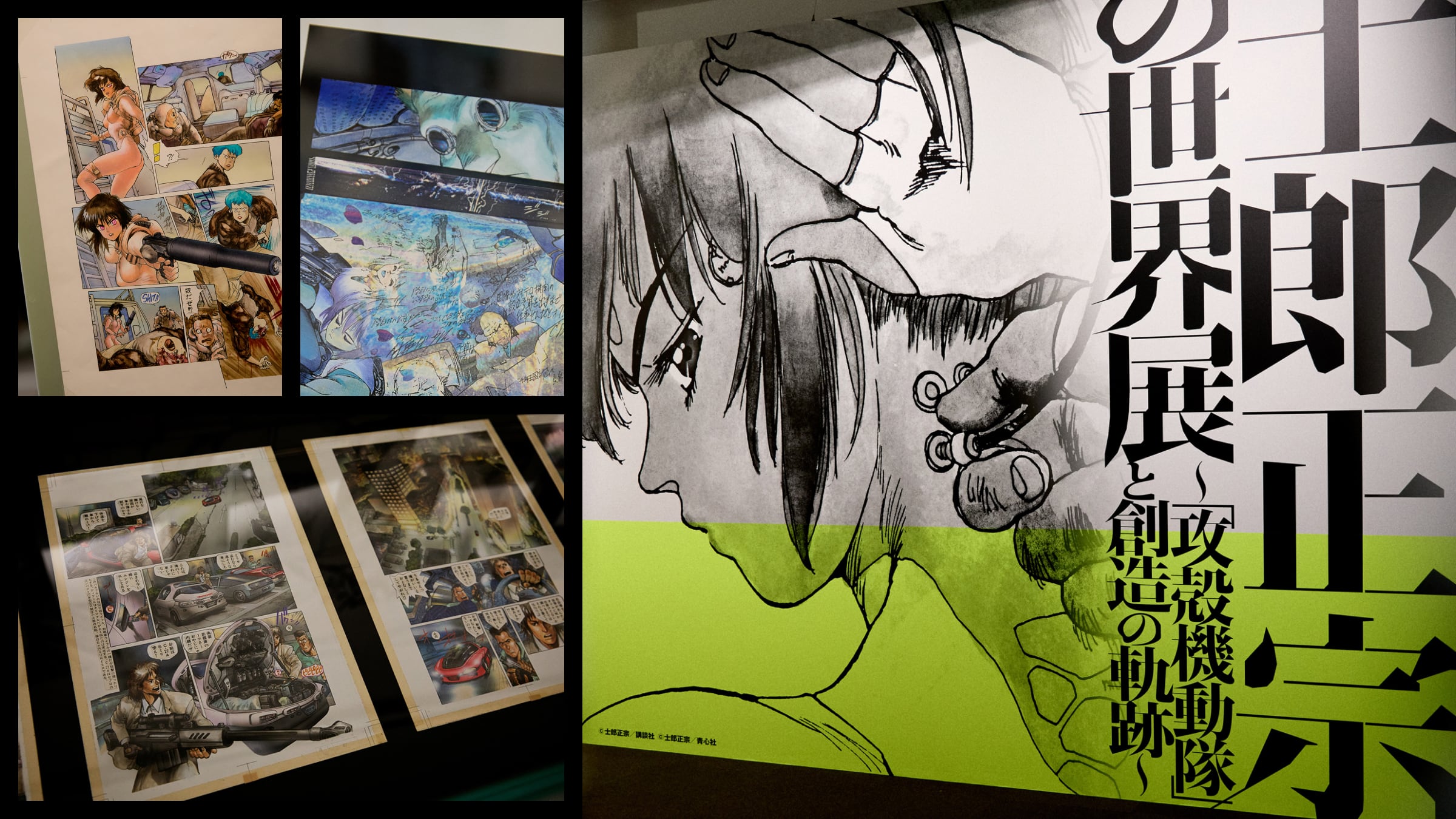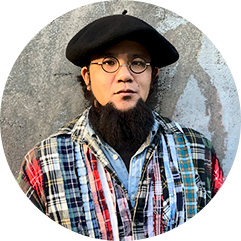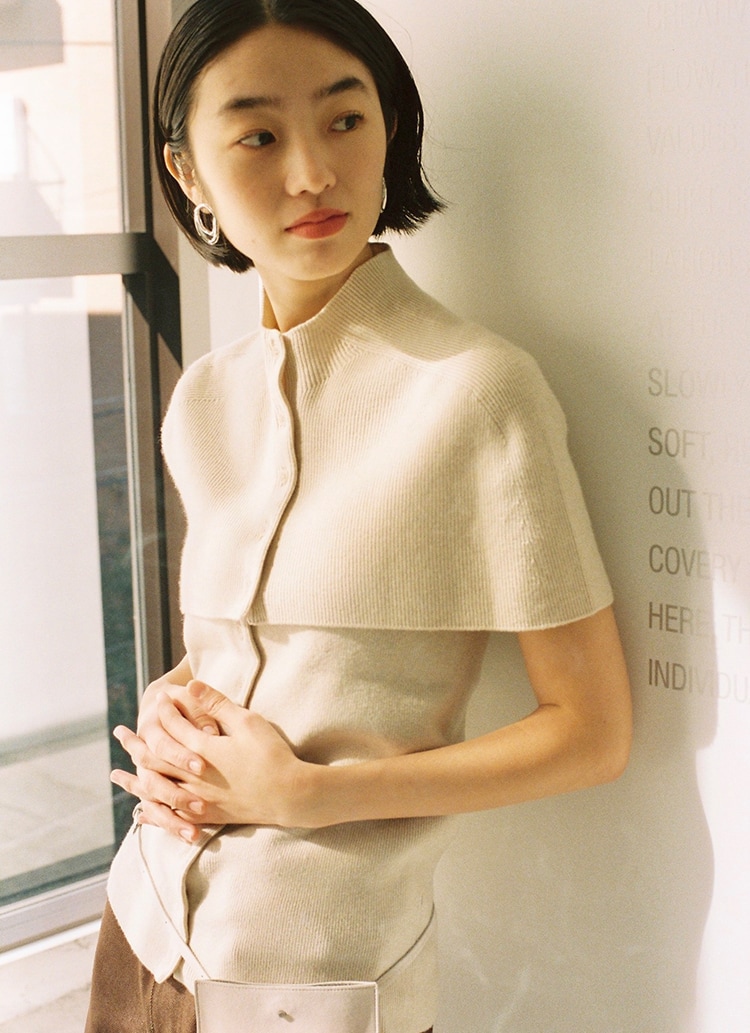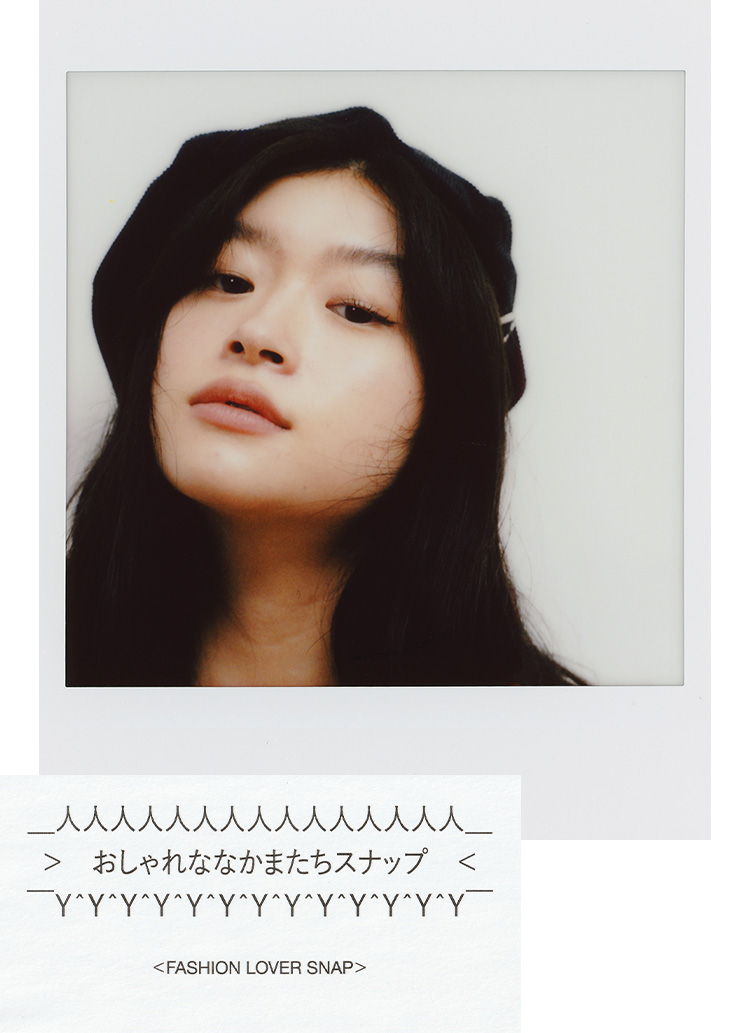Manga and anime are popular worldwide. While there are many masterpieces and masterpieces, the "Ghost in the Shell" series, along with Katsuhiro Otomo's "AKIRA," is one of the works that have influenced creators in many genres. The creator of the series, Masamune Shirow, is currently holding his first large-scale exhibition, "The World of Masamune Shirow: 'Ghost in the Shell' and the Trajectory of Creation," to rave reviews, so we visited the exhibition to report on the event. Whether you have not yet visited the exhibition or have already been there, please take this opportunity to read about it.
Photo_Sara Hashimoto
Text_Tommy
Edit_Yosuke Ishii
The editor in charge of the exhibition, who has worked with Shirow Masamune for about a quarter of a century, talks about the appeal of "The World of Shirow Masamune: "Ghost in the Shell" and the Trajectory of Creation.
Manga and anime have now become the most common synonyms for "the pride of Japan. The rare manga artist Shirow Masamune, who boasts of his worldwide popularity, has made great achievements in both fields. Shirow's works, with their precise plots, clever and bold compositions, and beautiful artwork, which reflect his unique worldview interwoven with philosophical exploration, have influenced many creators, and his work has expanded in a diverse range of genres.
This exhibition traces the history of Shirow's works and his current activities using analog and digital output manuscripts, as well as his library and comments, and delves into the personal side of "Shirow Masamune. 〜The venue is celebrating its 30th anniversary this year. The venue is the Setagaya Literature Center, which celebrates its 30th anniversary this year.
The first person to greet visitors is Motoko Kusanagi, a popular character from the "Ghost in the Shell" series, one of the most popular works in Japan. Unintentionally, we too were ready for battle, saying "Let's do it! and got ready for battle. Expectations naturally rose.
Now that you are fired up, the venue you are aiming for is on the second floor. At the entrance past the entrance and up the stairs, you will see a key visual depicting Motoko as well. Inside the venue beyond her sharp gaze are approximately 440 items on display, including more than 300 manga manuscripts, favorite working tools and art materials, books from the collection, and collaborative works with artists active in the fields of manga, animation, and contemporary art.
Navigating the exhibition halls is not as interesting as just looking around the exhibits in a vague manner. We therefore spoke with Tsuyoshi Katsurada, deputy editor-in-chief of Kodansha's "Young Magazine," the magazine in which the Ghost in the Shell series was serialized, and Shirow Masamune's handler for about 24 years since 2001, about the exhibition.
Tsuyoshi Katsurada / Assistant Editor, Kodansha Young Magazine
Please tell us how this exhibition started.
PARCO and Kodansha are collaborating on this project, and the impetus for this was the "AKIRA ART OF WALL" that was posted on the temporary construction fence of Shibuya PARCO on three occasions from 2017 until just before the opening. Through this connection, I had been in constant communication with Mr. Kobayashi of the "PARCO MUSEUM TOKYO" and he mentioned that he would like to redefine Shirow Masamune at some point in time. I decided that the year 2025, which would mark the 40th anniversary of the serialization of "Appleseed" in commercial magazines and the 30th anniversary of "Ghost in the Shell," an animated film directed by Mamoru Oshii, would be a good time to start the project. That was the starting point for this exhibition.
The culmination of the "AKIRA ART OF WALL" exhibition will be held in 2019, so the project has been in motion for quite some time. How did you decide on the content of the exhibition?
First of all, we asked Mr. Shiro to provide us with all of the raw manuscripts that he could produce at the moment. However, he had been saying since 2001, when I was assigned to him, that most of the manuscripts in the collection had been damaged by the Great Hanshin-Awaji Earthquake (1995), and that it would be difficult to find them in the warehouse! I asked him to help me find them in the warehouse, and he sent me the manuscripts he had unearthed. I asked him to help me find them, and he sent them to me himself. Then, out of all the raw manuscripts that came out, I curated them according to the exhibition theme.
The manuscripts are not kept by the publishers, are they?
We kept "Ghost in the Shell 1.5" at our company, but we had returned the manuscripts of the earlier works to Mr. Shirow, so he had them all himself. The problem there was the condition of the manuscripts, as I mentioned earlier. We were concerned because it would be difficult to go to the trouble of doing revision work for this exhibition, but we were able to get a copy of the fifth volume of "Appleseed" (*The title "Artemis no Tohya" was serialized in a magazine, but was interrupted. The serialization is included in "Shirow Masamune Hyper Notes"), or the raw manuscript of Ghost in the Shell, so I think the exhibition turned out very well in the end.
It is quite a precious experience to be able to see them with the naked eye and at such a close distance.
It is not as if the general public has never had the opportunity to see them. When I came into contact with the raw manuscripts again, the thing that struck me the most was the charm of the raw manuscripts from the analog era. Shirow's drawings from that time are very colorful and beautiful. Normally, it is natural that there would be uneven solid coloring or areas where he had made mistakes and corrected them with white paint, but there were none of these. It is strange to say that Ghost in the Shell in particular does not look like a manuscript, but it is so beautiful that it looks like a reproduction of the original.
Is that true from the stage of drawing the name (a kind of blueprint when drawing a manga)?
Nervousness. The draft of "Appleseed" on display at this year's exhibition has an overwhelmingly small number of unnecessary lines. It looks like a rough draft that just needs to be penciled in, and yet there is a lot of information on the screen, and it is very dense.
I heard that Katsuhiro Otomo (Manga artist / masterpiece "AKIRA" etc.) does not draw his stories, but pens them directly.
I guess so. He drew the first part of "AKIRA," but he got tired of it and just drew a series of frames, but the frames were not divided as a page. So I think that the story was already completed in your mind, and you put it together like a puzzle as you drew it out.
I guess that's what gives it its unique drive.
So there is a difference between the magazine serialization and the book version of "AKIRA". In the case of Shirow's work, there were so many additions and corrections in the book that I thought, "What's the point of serialization? (laughs).
In terms of the sense of a sense of drive, it is interesting to note the annotations, or rather the text, written outside the columns.
That's because he is the one who set up the story (laugh). Manga inevitably contains parts of description and expression that would never be possible in real life, but which cannot help but be false. Since it is a fiction and entertainment, it has to be stripped down in various ways, and that is why Shirow wants to make a point in his own way. He wants to say, "This is the reason and intention behind this production" (laughs). That's why he wrote so much passionately outside the column.
I don't know if that's why the text outside the column has the feel of a doujinshi of the time (laughs).
Although he now publishes his works in commercial magazines, he started out as a coterie artist, so he is a geek, isn't he? The cover design for "Dominion" is also on display, and he even specified the colors himself. That's what makes him so appealing to people who like him.
The page on "Orion, the Sacred Shell," which was enlarged and displayed in a large size, was very difficult to understand, and the annotations outside the column to explain it were very difficult to understand.
Yes, while it captures the reader's imagination, we ordinary people don't really understand it (laughs). That's exactly why we need an instruction manual to decipher the annotations.
But the difficulty of the work is also what stimulates the otaku in me. Many of the younger generation of Huinamu readers have only been exposed to Shirow's works in anime, so I think this will be a very shocking and fresh experience for them.
I think that seeing the same work in print is completely different from seeing it in a raw manuscript. Perhaps it is simply the amount of information that can be read, but I think people would be surprised at how detailed and beautiful a manuscript can be.
The color manuscripts, both analog and digital, are very beautiful and truly compelling.
It is beautiful. One of the most interesting points is that the pattern of the character's background is made by a color copy machine. I think it's impossible to reproduce it with today's copy machines, on the contrary. For example, the picture spread of the prologue of Ghost in the Shell. The image is based on the reflection of light from the scan of aluminum foil on the color copy machine, and the retouching was done by the artist himself. The sense of error or incompleteness of the work must have been what Shirow was looking for in his worldview.
This is the cyberpunk feel of the time, isn't it?
At the root of all these is a great sense of drawing. For example, in Shirow's works, there are many pictures that are drawn from the bottom up, but that is difficult. The artist has to draw all the way up to the top of the screen, and the character has to draw the nostrils as well, which makes it look tacky. Moreover, the perspective makes the face itself smaller, which is a composition that the artist wants to avoid. The reason why Shirow-san actively draws the face in this way is to increase the amount of information to convey the surrounding situation and world view. Therefore, the density per frame is really exquisite, and I think he is even better than Otomo in this respect.
Even when the panels are enlarged, they still look very fine! Even when the panels are zoomed in, you can still feel the detail. By the way, what kind of pen do you use?
His work tools are also on display, along with his personal reference materials. I think Shirow's writing pressure is a little high. Also, as shown in the timeline at the entrance of the exhibition, Shirow did all of his drawings by himself, without any assistants. And yet his hands are fast!
I think it is more interesting to listen to the explanation of the editor in charge of the exhibition.
This is also interesting. Only the drawn text is drawn on transparent film and pasted on top of the film. This way, when publishing overseas, there is no need to modify the drawn text for the overseas market, which makes it very easy.
Please let us know if there are any other highlights!
Earlier we talked about aori pictures, but Shirow's framing is also genius. Most artists these days tend to use a cut-out style, but Shirow's framing is very precise, creating a three-dimensional effect while creating depth. It is very difficult to fit all the information into a small frame in a composition that is just like an animator's storyboard. It is because of this skill that Mr. Toriyama, Mr. Otomo, and Mr. Shirow are able to create their animations.
I see.
In my mind, someone who can draw a close-up is someone who is good at drawing. While close-ups are flashy and less tedious to draw, pull-ups are tedious to draw because of the increased amount of information. But the pull-out frames make the "world view and positional relationship between characters" clearer. The aerial battle in "Dragon Ball" is a good example. With the vertical clouds on the screen, even a child can read the story with a clear image in his or her mind of "who is in what position.
It's very informative. Speaking of which, do you have a concept for the exhibition layout?
The exhibition is not a gallery style, but rather an open space where visitors can view the exhibits in any order they like, according to their own rhythm. Although the number of works is smaller than those that have been exhibited at the Setagaya Literature Center, as you can see, each work is incredibly dense and informative, so I think it is as good a show as you will ever see.
When you go back to the first work, you will discover something new. It is possible because it is not a gallery-style exhibition.
Therefore, the aisles are wide enough to prevent traffic jams. Also, the year 2025 will mark the 30th anniversary of the Setagaya Literature Center, so the entire surface of the wall was stripped and used as is to express the museum's accumulated history.
Your works have a cyberpunk worldview depicting the future, but they also have a sense of reality, or a connection with the present day. Is there a connection to that as well?
There is an affinity there, too. Even the design of a single mecha in the work has its own logic, and there is a sense of reality.
What is the job of the editor in charge after the series ends?
I believe that our mission as editors is to maximize the talent of writers, so we have to think about how we can promote the works we receive to the world. I also want to give shape at some point to something that exists in Shirow's mind but has not yet taken shape.
In the case of GHOST IN THE SHELL, new works continue to be created.
I think it's a good thing. Next year, there will be a new animation "Ghost in the Shell," and the work continues to be very active.
The second special version of the special report was also shown exclusively at the venue, raising the anticipation for the new film even higher.
I want to make it a "culture" like "AKIRA". Mamoru Oshii's "95 years" (*Theatrical animation "Ghost in the Shell") has become a worldwide phenomenon, and I feel strongly that we must convey to the world that Masamune Shirow, the originator of "95 years," is a great person as well. I feel strongly that we must convey to the world that Shirow Masamune, the originator of this movement, is an amazing person as well. When the younger generation sees the original manuscripts on display, they will think they are extraordinary, and I am certain that they have that much potential.
In terms of potential, not only the characters but also the mecha designs are simply "cool! I feel it is very cool.
It is important to look good at a quick glance.
There is also the example of Akira Toriyama (manga artist and masterpiece "Dragon Ball"), whose design work has been reevaluated since his death.
Shirow-san's opinion of Toriyama-san is also very high, and he often says, "It's wonderful that he can draw like that. In fact, Shirow is also influenced by Otomo and Toriyama.
What other writers have influenced you?
As mentioned in the exhibition text, he grew up in a female-headed family, sandwiched between an older sister and a younger sister, so he may have been influenced by female authors such as Yukari Ichijo (manga artist, whose representative works include "Suna no Shiro" and "Arikan Club").
I'm sorry to change the subject, but there is a great selection of goods for sale at this exhibition, isn't there?
Actually, we're still trying to keep the numbers down (laughs).
What?
We had a huge number of design ideas and item ideas. To be honest, we wanted to make all of them, but that would have been a bad idea, so we settled on the current lineup in tears.
What are some of your favorites?
In this regard, the art book "Shirow Masamune Artworks in the Shell," published in conjunction with this exhibition, seems to have been quite well received. Personally, I also like the T-shirts and other apparel products because they are very well made. Moreover, there has never been an official commercialization of the original manga until now. So all the products available in the world are bootlegs. I think the fact that they chose the same graphics as the boot version makes it a valuable item.
That's exactly the approach of GEEKS RULE, with which we are collaborating this time. This is an item that fans have been waiting for.
Yes, that's right. I had not used the original work because the animation had been running for so long, and I did not want to get in the way of that.
Fans will be happy to know that you have T-shirts of all the exhibited works.
Normally, we don't make so many different kinds of T-shirts, just for key visuals (laughs).
There are a total of 11 types of original exhibition goods alone! The apparel lineup is spectacular, with four types of T-shirts, four types of hoodies, two types of caps, four types of tote bags, three types of bandanas, and four types of hand towels.
In addition to Geeks Rule, there are also collaboration items with Brain Dead, Saint Michael (©️SAINT Mxxxxxxxx), MEQRI, BE@RBRICK, and MAXFACTORY! There are also many other goods such as stickers and posters.
I can never get all of them in one visit to the exhibition (laughs). Once again, I feel the greatness of Mr. Shirow.
The reason why we were able to realize such a large scale exhibition was because of "the charm of Shirow's drawings. That is the only way to put it. The exhibition will run for four months, from April 12 to August 17, and we are sure that you will discover something new each time you visit or see the exhibition.
This is a report about a month late from the event.
Although some of the merchandise may already be sold out, now is the time to visit the museum after the Golden Week holidays! The photo spot where the cover art of the first volume of Ghost in the Shell can be reproduced will be relatively empty, and you can get a mini card illustrated by Shirow Masamune (6 kinds in total) as a special prize for visiting the museum on different days during the exhibition period (*Only for those who purchase an admission ticket, each person is limited to one card; the cards for 7/21 (Monday, holiday) and 8/11 (Monday, holiday) will have the Tuesday patterns). ), you will inevitably want to go again and again.
Why don't you dive into the vast and profound "world of Shirow Masamune"?
And one last piece of advice. Do not miss out on the catalog "The World of Shirow Masamune - "Ghost in the Shell" and the Trajectory of Creation" available at the sales venue!
Why? It whispers to me that there is no doubt about it, my ghost.
The World of Shirow Masamune Exhibition
〜Ghost in the Shell" and the Trail of Creation
Dates: April 12 (Sat) - August 17 (Sun), 2025
Location: Setagaya Literature Center (1-10-10, Minamikarasuyama, Setagaya-ku, Tokyo)
Hours: 10:00 - 18:00 *Last admission 30 minutes before closing. Closed on Mondays (if Monday is a national holiday, the museum will be open on Monday and closed the following day).
Official Site
Organizers: Setagaya Literature Center, Setagaya Cultural Foundation, Kodansha, Parco
Planning cooperation: Seishinsha
Special cooperation: Shirow Masamune
Supported by: Setagaya Ward, Setagaya Ward Board of Education
Graphic Design: Kei Sakawaki, Hiroaki Tobitaka
Spatial composition: Trough Architects & Engineers, Inc.
Web design: Rhino inc.










